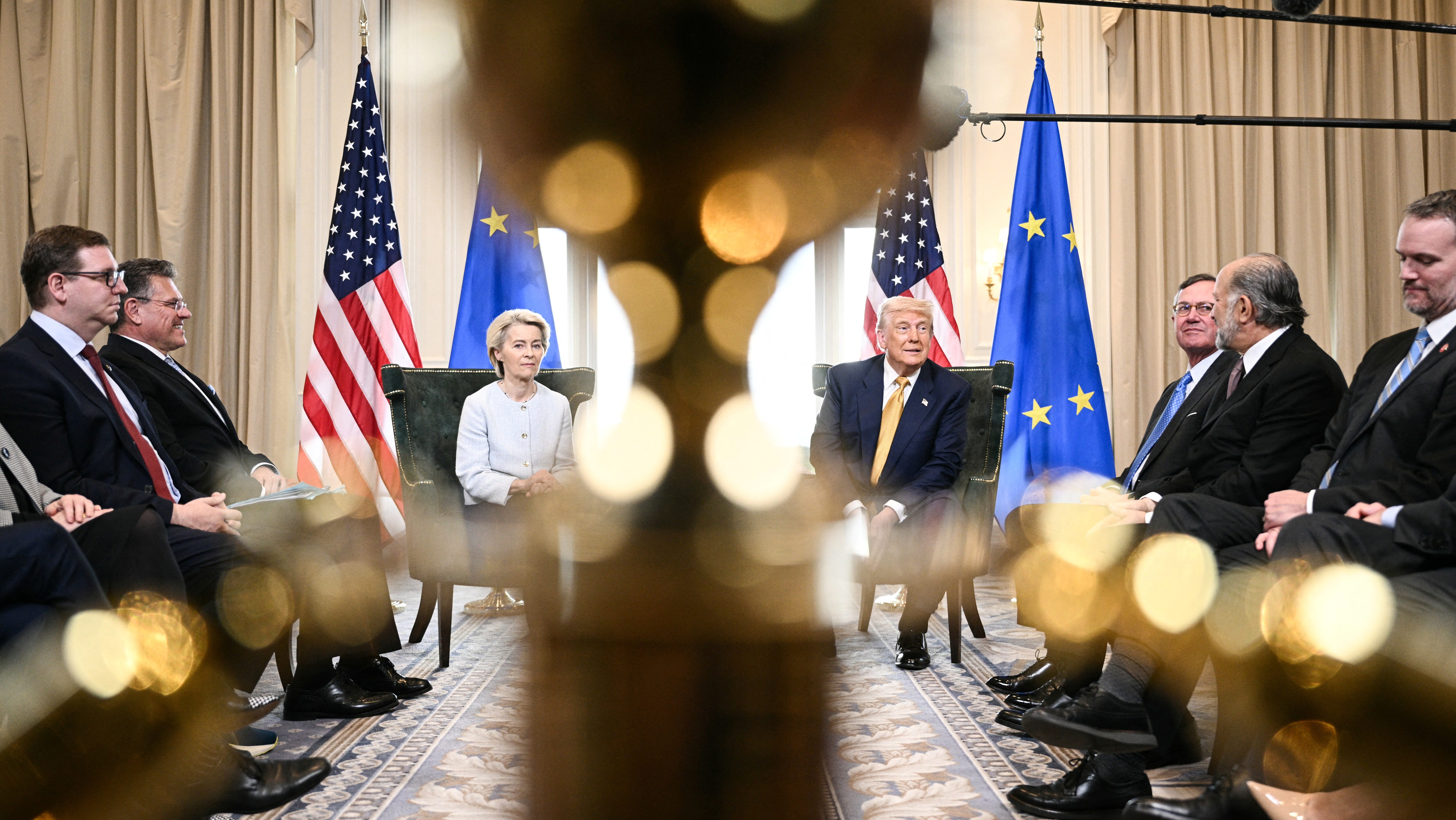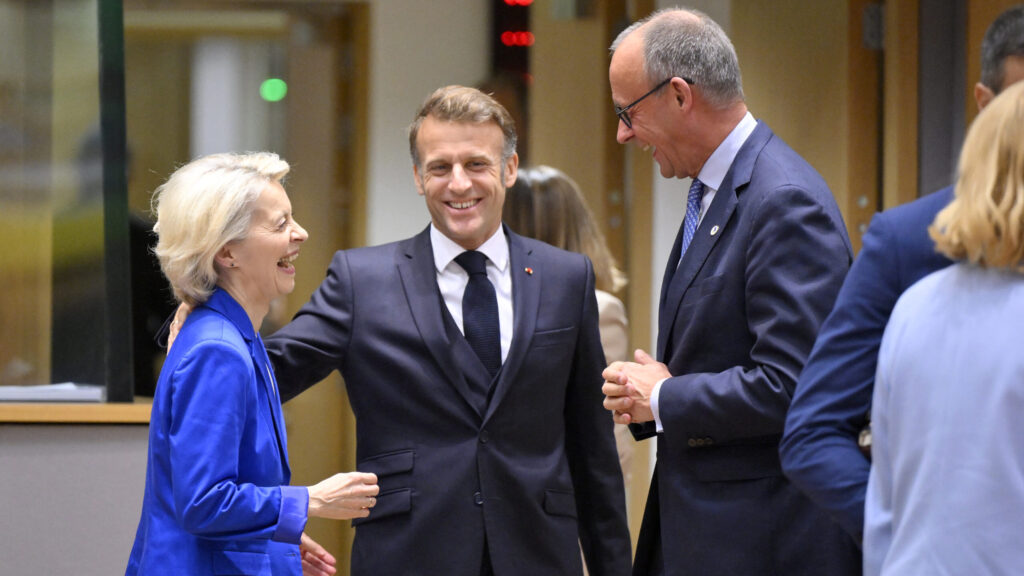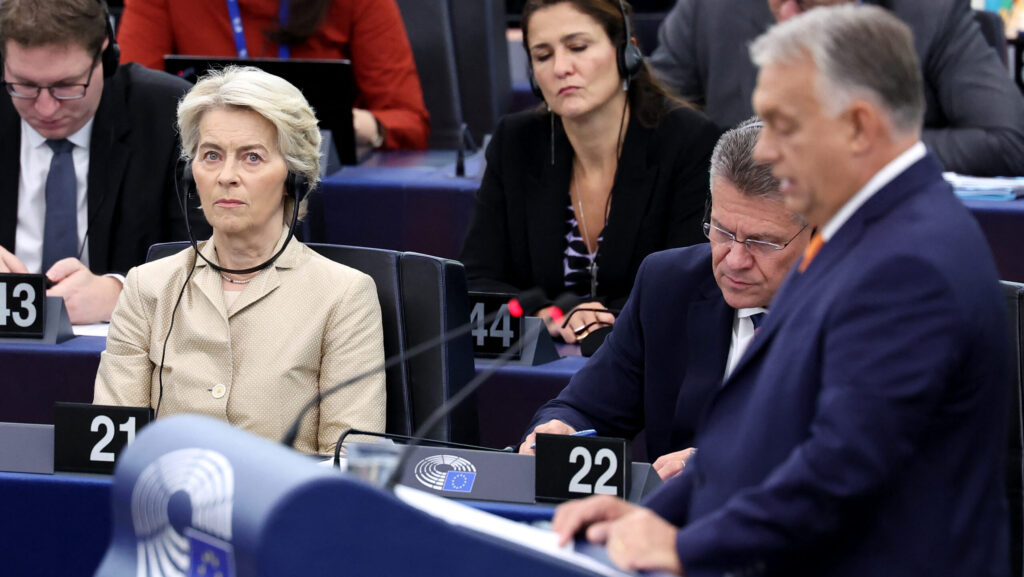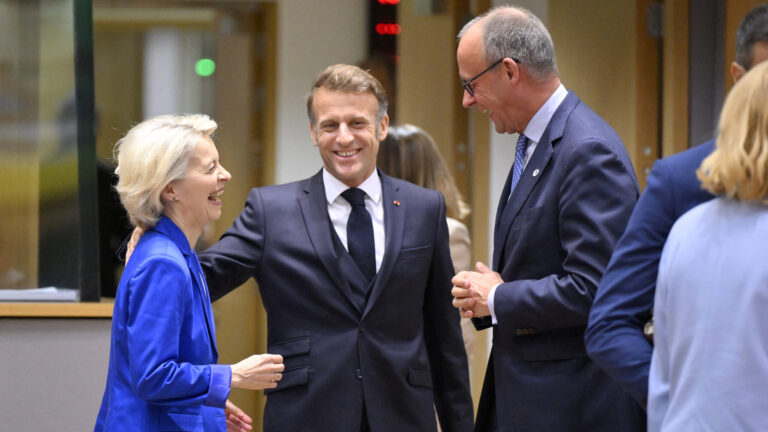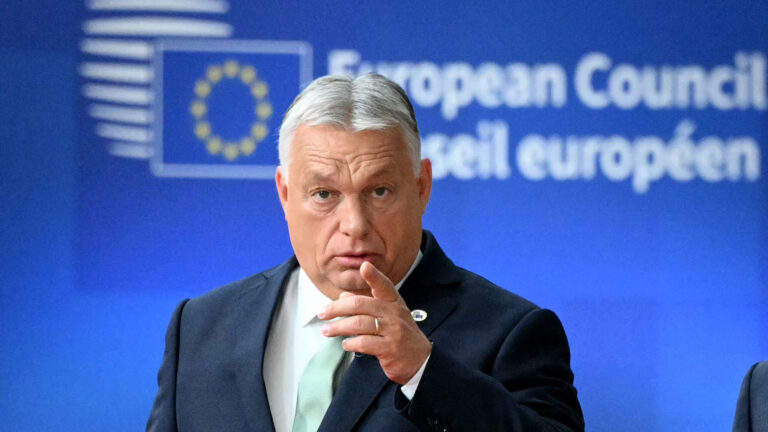US President Donald Trump and European Commission President Ursula von der Leyen struck a deal on Sunday, 27 July, locking in a 15 per cent tariff just days before the 1 August deadline. ‘This is the biggest one of them all,’ Trump emphasized to reporters at his Turnberry golf club in Scotland, where von der Leyen visited him at short notice.
In this instance, Trump is right. The deal is likely one of the most favourable Washington has secured since the president launched his tariff showdown a few months after taking office. The European Union as a whole, however, cannot be as satisfied with the so-called ‘hard-fought’ agreement as Trump.
US Takes It All While EU Gets Close to Nothing
While it is certainly preferable—at least in a short-term—to the worst-case no-deal scenario, a closer reading of the agreement’s details, coupled with the joint press conference held by von der Leyen and Trump, leaves the impression that the Commission and its President—vested with exclusive negotiating authority—have let down the member states, or at least a number of them. ‘Outgunned’ by Trump, they appear to have accepted a subordinate role by endorsing a deal that is, in many respects, unfavourable: one that significantly deepens Europe’s strategic dependence and, arguably, weakens its overall competitiveness.
According to the agreement, most European goods entering the United States will now be subject to a 15 per cent tariff—a middle ground between earlier threats of up to 30 per cent. This rate applies broadly to consumer and industrial goods. Steel remains subject to a 50 per cent tariff, in line with existing US policy. One of the few notable successes of von der Leyen’s negotiating team is that several strategic sectors—including pharmaceuticals (generics), aircraft and component parts, certain chemicals, semiconductor equipment, agri-products, and raw materials—have been placed under a ‘zero-for-zero’ tariff arrangement (meaning neither side applies tariffs in those sectors).
‘The EU agrees to import up to $750 billion in energy products from the United States’
Moreover, the EU agrees to import up to $750 billion in energy products from the United States over a three-year period, amounting to around $250 billion annually starting from 2026. Most reports indicate that liquefied natural gas (LNG) will constitute a significant portion of these imports—Washington provided 45 per cent of the bloc’s LNG imports in 2024, totalling around $13 billion—alongside oil, nuclear energy, and other resources. Total EU energy imports stood at around $440 billion last year, suggesting that the American share could rise to as much as 50 per cent in 2026 under the new deal—still about 10 percentage points below Russia’s 2021 share, but significantly more than Moscow’s 2024 figure of around 15–19 per cent.
Brussels also pledged to invest $600 billion in the US economy, with no specific timeframe mentioned, including ‘vast amounts’ allocated to purchases of military equipment as part of this commitment. While no concrete details have been disclosed, reports suggest that the commitment is broadly defined under investment rather than a precise procurement plan. It also appears to overlap with the US–NATO deal announced by Trump earlier in July, according to which Washington will continue supplying military equipment to Ukraine, with the cost to be covered by European NATO member states.
Strategic Overdependece
It is clearly visible through the deal that it aligns with the EU leadership’s broader vision of phasing out Russian natural gas and oil from its energy imports by 2027. Besides the goal of weakening Moscow’s war effort, the most frequently cited justification is to diversify the EU’s energy mix, terminate overdependence on a single source—namely Russia—and thereby ensure a more stable and secure energy supply among the Member States of the bloc. The $750 billion commitment, however, does precisely the opposite: Brussels is replacing Russian dependence with American dependence. In addition to defensive and economic reliance, the EU is now surrendering the possibility of maintaining a sovereign energy policy independent of Washington. This is an especially curious move from a leadership that has, for months, argued that the United States under Donald Trump is an unreliable partner. If that is the case, why are we granting them leverage over half of our energy imports?
Beyond the clearly visible risk of strategic overdependence, LNG is generally three to four times more expensive than Russian natural gas. Moreover, the latter has historically operated on the basis of long-term contracts with stable pricing, whereas American LNG is tied to global spot markets and is often subject to greater volatility—particularly during periods of heightened demand from Asian buyers or shipping disruptions. This means the EU would become more vulnerable in times of crisis. While infrastructure for pipeline-delivered natural gas is already in place and functioning, LNG terminals—required for storage and regasification—are still lacking in many parts of the EU, including Hungary, further raising the cost of transition.
Hungary is among the member states likely to suffer significant disadvantages as a result of the deal. The country currently enjoys the lowest utility costs across the bloc, with household gas priced at $0.038/kWh in 2024, compared to the EU average of $0.14/kWh. This is a direct consequence of Prime Minister Viktor Orbán’s cost-reduction strategy, grounded in access to cheap and predictable Russian gas. It is therefore unsurprising that Orbán opposes the phasing out of Russian energy sources, as replacing affordable gas with American LNG could lead to a 10 to 30 per cent increase in household utility bills.
‘The EU is now surrendering the possibility of maintaining a sovereign energy policy independent of Washington’
The automotive and manufacturing sectors are also heavily impacted under the new deal. Before the war in Ukraine, European competitiveness was driven in large part by access to cheap Russian energy, one of the key contributors to the continent’s growth in recent decades. The negative effects of transitioning to LNG are already evident when examining Germany’s once robust automotive and manufacturing industries. The chemical sector in the country is already in recession, attributable in part to the loss of cheap Russian gas, with BASF and other firms having scaled back domestic operations. However, the downturn is far from over, and the current deal will further exacerbate already severe consequences. A broader industrial decline is underway—enterprise conditions in manufacturing remain weak, investment is falling, and Germany has entered recession in both 2023 and 2024. The energy transition is frequently cited as a core structural challenge.
Hungary’s automotive sector is closely tied to that of Germany, which is a key reason why the country’s economy has lagged in recent years. A forced transition would lead to further declines in competitiveness, translating into higher energy costs, increased volatility, and heavier infrastructure burdens. The country’s export-oriented economy is also strongly affected by tariffs, particularly given that the US accounts for 15 per cent of Hungary’s non-EU exports, with the automotive sector responsible for a significant share. According to various assessments, the deal could result in a 0.7 to 1 percentage point reduction in GDP for Hungary—more than double the estimated EU average of 0.4 to 0.5 percentage point for 2025–2026. In a no-deal scenario—assuming a 30 per cent tariff on all goods, but without the $750 billion energy import obligation—Hungary’s GDP loss would be around 0.5 percentage point, and the EU’s around 0.3.
Resistance Is the Only Option
Hungary will hold elections in 2026, with Orbán facing a genuine opposition force for the first time in 15 years. The country enjoyed robust economic growth in recent years, only to be disrupted first by the COVID-19 pandemic and then by the war in Ukraine. The new deal represents yet another blow to Hungary’s economic trajectory, putting the governing parties in a difficult position just months before the elections. Orbán commented on the deal on Monday, stating that Trump ‘ate von der Leyen.’ ‘The EU–US agreement is worse than the UK–US deal. It’ll be hard to present this as a success,’ the Hungarian prime minister remarked.
But what can dissatisfied member states do in response to the deal? At present, resistance appears to be the only option. Besides Hungary, Slovakia is also likely to be heavily affected by the agreement’s energy import clause, given its significant reliance on Russian energy. Just days before the deal was announced, Bratislava declared that it would import 100 per cent of its natural gas from Russia through 2027. Last week, Hungarian Minister for Foreign Affairs and Trade Péter Szijjártó also announced that Hungary is constructing a new oil pipeline in cooperation with Serbia and Russia. Both initiatives run directly counter to Brussels’ phase-out strategy and to the US–EU deal—or, as some have termed it, a neo-colonial agreement to sell out Europe to America.
Zoltan Kovacs on X (formerly Twitter): “🇺🇸🇪🇺 @PM_ViktorOrban on Warrior’s Hour: This wasn’t a deal-@realDonaldTrump ate @vonderleyen for breakfast. He’s a heavyweight negotiator; she’s a featherweight. The EU-US agreement is worse than the UK-US deal. It’ll be hard to present this as a success. pic.twitter.com/Bet1YJ23BS / X”
🇺🇸🇪🇺 @PM_ViktorOrban on Warrior’s Hour: This wasn’t a deal-@realDonaldTrump ate @vonderleyen for breakfast. He’s a heavyweight negotiator; she’s a featherweight. The EU-US agreement is worse than the UK-US deal. It’ll be hard to present this as a success. pic.twitter.com/Bet1YJ23BS
Under existing EU treaties, only the European Commission has the authority to negotiate trade agreements, which means member states have little to no opportunity to represent their own interests during months-long negotiations. Both Orbán and Szijjártó have called for direct bilateral negotiations with the US, precisely to avoid outcomes such as the present one. Hungary has been reportedly in talks with Washington—largely based on the strong personal relationship between Trump and Orbán—across several areas, including defence, trade, and energy. This could indicate a possible opt-out from the framework deal. However, excessive optimism would be premature: beyond media reports, no concrete agreement has yet resulted from these discussions.
Due to its classification as a ‘mixed agreement’—meaning it contains provisions extending beyond trade—the deal requires the unanimous endorsement of all 27 member states at the level of the Council of the European Union. The vote is expected to take place on Thursday. If the framework is approved, national parliaments must subsequently ratify it, and it will only enter into force once all 27 have done so—effectively granting Hungary a quasi-veto over the entire deal.
Related articles:

